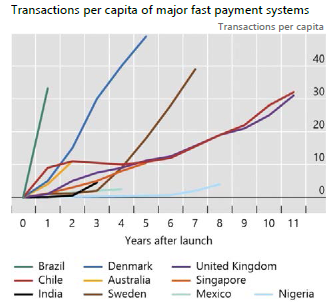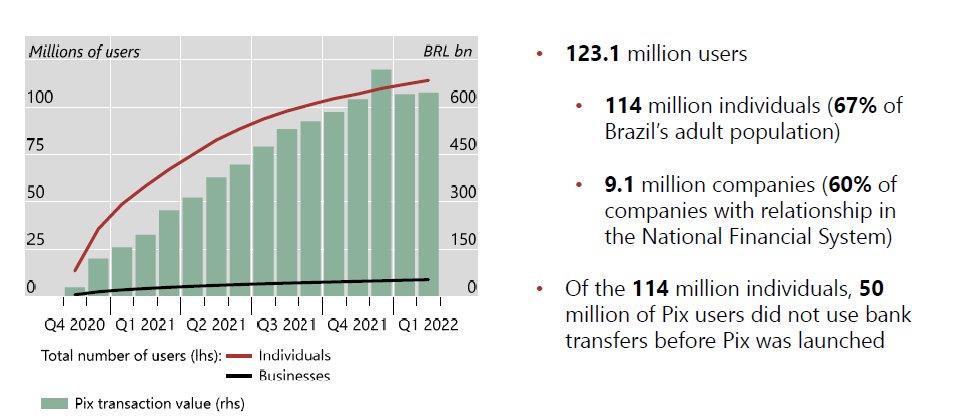
A quiet revolution in the monetary system started in November 2020, when Brazil launched its Pix instant payment system
In little over a year, it signed up two-thirds of Brazil's adult population
The latest #BIS_Bulletin tells the amazing story
A thread
bis.org/publ/bisbull52…
In little over a year, it signed up two-thirds of Brazil's adult population
The latest #BIS_Bulletin tells the amazing story
A thread
bis.org/publ/bisbull52…

The trajectory is even clearer in this chart which shows the relative adoption by comparison to other retail fast payment systems 

Technology is only part of the story; after all, technology is similar everywhere
Instead, the lessons are on the *economics*, especially the importance of an open payment architecture
Instead, the lessons are on the *economics*, especially the importance of an open payment architecture

The Central Bank of Brazil provides the payment infrastructure but also sets the rule book for service providers; digital ID and technical standards for data exchange (through APIs) ensure interoperability 

Pix is free for individuals and virtually free for merchants (in yellow in the chart below)
The contrast with credit card fees is very stark
The contrast with credit card fees is very stark

In spite of rapid technological progress in information processing in recent decades the cost of payments has remained stubbornly high
Users don't always see these costs (they are levied on merchants) but users will bear the ultimate burden if they are passed on as higher prices
Users don't always see these costs (they are levied on merchants) but users will bear the ultimate burden if they are passed on as higher prices
Adoption of Pix has been very rapid; it overtook pre-paid cards within months, and is poised to overtake credit and debit cards 

Two factors likely account for Pix's rapid growth
First is the mandatory participation of large banks, which set in motion network effects that drew in others
First is the mandatory participation of large banks, which set in motion network effects that drew in others
The second is the dual role of the central bank - as infrastructure provider and the overseer of the rule book
The data architecture (digital ID together with APIs that ensure interoperability) gives teeth to effective competition
The data architecture (digital ID together with APIs that ensure interoperability) gives teeth to effective competition
In fact, there are broader lessons for the roll-out of central bank digital currencies (CBDCs)
The data architecture consisting of digital IDs and APIs that ensure privacy has a lot in common with that for CBDCs
Pix gives a glimpse of what's possible
The data architecture consisting of digital IDs and APIs that ensure privacy has a lot in common with that for CBDCs
Pix gives a glimpse of what's possible

Some of you are asking in the comments section what all this means for advanced economies, especially the US
My panel at the #NABE with Nellie Liang covered some of this
Short answer is "a lot", especially on FedNow
My panel at the #NABE with Nellie Liang covered some of this
Short answer is "a lot", especially on FedNow
https://twitter.com/business_econ/status/1506351397809561600?s=20&t=eVH2XcNR2buElH4NFfGdMA
For more on the link between instant payment systems and CBDCs, the video of the #NABE conference session with US Treasury Undersecretary Nellie Liang and @jc_econ is posted on the conference site
nabe.com/NABE/Events/PC…
nabe.com/NABE/Events/PC…
It was a real pleasure to speak to Governor Roberto Campos Neto of the Central Bank of Brazil on Pix
Roberto described to me how Pix exemplifies the benefits of harnessing technology for the public good
Roberto described to me how Pix exemplifies the benefits of harnessing technology for the public good
My favorite part of this “fireside chat” was when Roberto discussed the reactions of the banking sector
At first, they were not happy; but they quickly realized the huge potential from having additional business lines
“Best way to persuade banks is to persuade their customers”
At first, they were not happy; but they quickly realized the huge potential from having additional business lines
“Best way to persuade banks is to persuade their customers”
Check out the other sessions of the #BIS_Innovation_Summit held earlier this week
bis.org/events/bis_inn…
bis.org/events/bis_inn…
• • •
Missing some Tweet in this thread? You can try to
force a refresh













